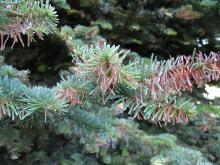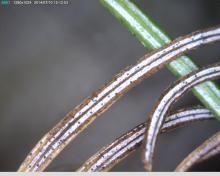By C. Landgren and G. Chastagner
See:
Fir, True (Abies spp.) - Current-season Needle Necrosis
Cause Delphinella abietis, ungus, may be a problem in Christmas tree, bough, and forest stands. Damage often is more pronounced on the north side of trees and in areas with tightly-spaced firs with poor air circulation. Prolong moist conditions and/or high humidity during bud break favor disease development. Currently known fir host species include noble, Fraser, sub-alpine, corkbark, Greek, Spanish, Siberian, white, Turkish, balsam, and European silver fir.
Symptoms Current season needles will turn a red-to-purplish color and bend downward. Symptoms occur shortly after needle elongation. Damaged needles remain attached to shoots for a year or more. Needles turn gray color with aging. Black fruiting bodies (pseudothecia) develop on symptomatic needles and release spores the following spring. Damage may resemble frost damage, Botrytis blight, or current season needle necrosis.
Cultural control
- Maintain open stands with good air flow.
- Thin bough stands and remove infected lower branches.
- Avoid overhead irrigation during bud break.
Chemical control Limited PNW trial information is available regarding fungicide efficacy. The following has been used by a number of growers. Applying chlorothalonil-based products may cause chlorotic or necrotic needle flecking.
- Bravo Weather Stik at 5.5 pints/A. Group M5 fungicide. 12-hr reentry.
- Daconil Weather Stik at 1.5 to 5.5 pints/A. Group M5 fungicide. 12-hr reentry.
- Echo DF at 2.25 to 4.5 lb/A. Group M5 fungicide. 12-hr reentry.
References Chastagner, G.A.; Riley, K., Eikemo, and Talgø, H. 2015. Delphinella shoot blight and Grovesiella canker on Abies lasiocarpa in western USA. p. 57 in The 12th International Christmas Tree Research and Extension Conference, V. Talgø, and I.S. Fløistad (eds.). …s, Norway: NIBIO.
Talgø, V., Skage, J.O., Steffenrem, A., Junker, C., Eikemo, H., Brurberg, M.B., and Johnskås, O.R. 2016. Delphinella shoot blight on Abies lasiocarpa provenances in Norway. Forests 7(1), 7; doi:10.3390/f7010007, 17 pp.



